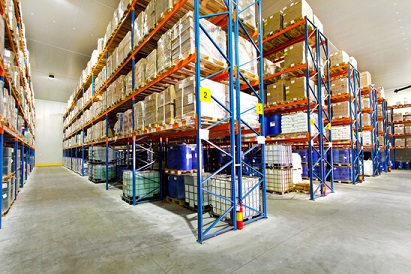Title Page
-
Site conducted
-
Client / Site
-
Building #
-
Location
-
Conducted on (Date and Time)
-
Inspected by
General Inspection
GENERAL WAREHOUSE AREA
-
Aisles clear and open for material transfers<br>• No product shall be stored in aisles where it blocks equipment maneuvering.
-
REFERENCE: Clean aisles. No materials are stored in walkways.
-
Floor and rack storage limits properly posted <br>• One sign near the entrance of the warehouse should indicate the floor rating. <br>• All racks should be labeled with load ratings.
-
Rack uprights and beams in good condition<br>• Bent racks and beams must be repaired or replaced. <br>• All racks should be bolted to the floor.
-
Designated open areas clear of blockage<br>• Such areas include 18 inch perimeters along interior walls as well as electrical panels and eye wash units.
-
Pallets in good condition<br>• Empty pallets must be stored properly. <br>• No broken or protruding wood or nails. <br>• No pallets on edge. <br>• Avoid storing empty pallets in quantities or densities in excess of O.H. fire sprinkler combustible load ratings.
-
Overhead lighting, skylights, and roofs in good condition<br>• Check for leaks, broken panels/light bulbs, and missing bulb shields.
-
Loose/unboxed materials stacked properly<br>• Properly stored by blocking, interlocking or limiting the height of the pile.<br>• Insure product stack heights are inforced to prevent container crushing and falling mate
-
Use of proper personal protective equipment when handling chemicals
-
Guardrails and/or covers provided to protect personnel from the hazards of open sides of stairs, platforms, floor openings, floor holes, mezzanines, equipment pits, and other possible fall hazards
-
Elevators and hoists for lifting items properly used<br>• Have adequate/safe clearances, no obstructions, appropriate signals and directional warning signs. <br>• Documented annual inspections by licensed inspector are posted on the equipment and on file.
-
Appropriate safety posters posted in a conspicuous place including non-smoking signage
-
Chemicals stored according to the manufacturer’s recommendations and local or national fire codes. (i.e. flammable cabinets, cans, etc.)
-
Proper lifting techniques used for the materials being handled
-
Products and containers that are most frequently moved by hand are stored at rack heights that minimize bending / stooping or excess reach to pick up or place
-
Employees properly outfitted for weather/temperature extremes? (i.e. heat stress, cold weather, refrigerated storage areas, etc.)
DOCK AREAS (INTERIOR AND EXTERIOR)
Dock Areas (Exterior)
-
Approach roads and staging areas (yard) clear for maneuvering, well drained, free of potholes and are all signs in place and legible
-
Approach to the dock well drained and free from potholes or other obstructions <br>• Pay particular attention to snow, ice, storm water and debris build up.
-
Dock positions clearly marked with painted lines that the drivers can see to help them spot their trailer accurately
-
Safety chains are attached across docks above 36” in fall hazard ares?
-
Exterior lights working properly<br>• This item will need to be inspected during the evening when lights are functioning.
-
Wheel chocks and/or trailer restraint systems working properly<br>• If trailer restraint systems are in use remember to inspect for proper locking and indicator light function both inside and outside. <br>• Ensure tractors are disconnected from trailer.
Dock Areas (Interior)
-
Visitors and drivers remaining in designated safe areas and walkways
-
Interior overhead lights and trailer lights in the dock area operating properly <br>• Test all lights that might be off at time of inspection to be sure they work properly
-
Dock doors work properly and close completely<br>• Ensure that all doors in use open and close smoothly. <br>• Inspect automatic stops and auto-reversing functions on powered doors
-
Dock doors closed when not in use<br>• Closed doors should seal well with the floor and dock leveling plate.
-
Sufficient room to maneuver materials<br>• Dock area floors should be clean and free of trash, debris, or stored items that block the safe passage of loaded equipment
-
Sufficient waste cans for the area, properly labeled and emptied on a regular basis<br>• In general, floors, ceilings, and exhaust fans are clean and free of cobwebs and dust buildup.
-
Adequate natural or mechanical ventilation to control any potential atmospheric hazards
EQUIPMENT
Equipment Checks
-
Ladders and hand tools are in good condition<br>• Remove any unsafe equipment from service while awaiting repair.
-
Forklifts being operated safely and inspected at the start of every shift <br>• Observe powered industrial truck operations and review training certifications to confirm operators have been adequately trained and evaluated.
-
Forklifts have functioning warning devices such as back-up alarms, strobes, or horns<br>• Test equipment as needed, report repairs, and tag out equipment that is unsafe until repairs are made.
-
Battery charging/changing areas designated for that purpose and contain appropriate emergency flushing facilities (i.e. eyewash and shower)
-
Guards in place for any hazard points on moving equipment such as belt guards on compressors or conveyors<br>• Inspect all powered work tools as well (i.e. cords, insulation, shrouds, casing, guards, etc.).
-
Propane tanks stored correctly and are the tank exchange and/or tank filling areas properly maintained <br>• Appropriate signs are in place and area is free of trash.
Power Industrial Vehicles
Product Storage
-
PPE is used when battery maintenance is performed.
-
Completion
Completion
-
Full Name and Signature of Inspector










